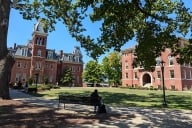You have /5 articles left.
Sign up for a free account or log in.

Buyouts and restructuring at Penn State are part of a larger effort to trim nearly $100 million by fiscal year 2026.
Photo illustration by Justin Morrison/Inside Higher Ed | Luis Quintero/pexels | Dilok Klaisataporn/Getty Images | skynesher/Getty Images
As struggling institutions across Pennsylvania closed this month, Pennsylvania State University took steps to address its own financial issues—namely by offering employees buyouts and consolidating leadership positions, which administrators expect will help ease budget woes.
In all, 383 employees—or 10 percent of the workforce at Penn State’s 20 Commonwealth Campuses (regional campuses)—participated in the voluntary separation incentive program (VSIP) that was offered last month. Officials expect to save $43 million through the buyouts plus a restructuring effort that will combine 11 Commonwealth Campuses into four regional groups, each overseen by a chancellor. The buyouts are part of a larger effort announced by administrators earlier this year to trim almost $100 million from Penn State’s fiscal year 2026 budget, which includes an academic portfolio and program review that could yield job cuts in the future.
The changes come as many colleges across the Keystone State face financial challenges.
Just this month, University of the Arts closed abruptly, Pittsburgh Technical College announced it will end operations in August, and the for-profit Triangle Tech shuttered six campuses. Meanwhile, enrollment at Penn State’s Commonwealth Campuses has plunged in recent years.
A Looming Budget Crisis
Penn State launched the voluntary separation incentive program on May 8, giving eligible faculty and staff members until the end of that month to opt in. In announcing the buyout program, President Neeli Bendapudi underscored “the challenges facing all of higher education,” noting the university’s need to “evolve in order to continue serving the residents of Pennsylvania.”
The buyouts were limited to employees at the 20 Commonwealth Campuses, where combined enrollment slipped from 27,939 students in fall 2019 to 23,682 in fall 2023, according to university data. Over that same period, the flagship in University Park saw its enrollment climb from 46,723 to 48,535, Penn State figures show.
“Enrollment has declined significantly at the Commonwealth Campuses, in aggregate, over the past 10 or so years while the number of faculty and staff at the campuses has remained relatively flat,” Penn State officials wrote on a webpage answering Frequently Asked Questions (FAQ) about the buyouts. “The University must reduce its overall operating costs and prioritize funding for investment in student-focused initiatives, and there is no way to do this without addressing personnel costs.”
Employees who participate in the separation program will receive a one-year salary and health insurance subsidies for six months. About half will leave at the end of this month, while others will serve through the end of the year, according to details released by the administration.
Penn State leaders noted on the FAQ page that the “program is designed to help address specific challenges at the Commonwealth Campuses,” adding that they have no plans to implement buyouts at the University Park Campus, the law schools, or the College of Medicine.
“However, that decision may be reevaluated based on future needs,” they wrote.
In addition to the buyouts, Penn State has announced changes in the leadership structure for some Commonwealth Campuses. Historically, each campus had its own chancellor. But with some retiring or taking buyouts, officials saw an opportunity to reduce overhead by consolidating leadership positions, putting some chancellors in charge of multiple campuses.
What’s Next?
With the buyout numbers finalized and leadership changes in place, many faculty members have lingering questions about what will happen going forward. Others have raised concerns about the alleged lack of transparency in the process.
Michele Stine, Faculty Senate chair and a professor of biobehavioral health at the flagship campus, told Inside Higher Ed that the announcement of the buyouts in May “felt very rushed and very sudden” and left employees with limited time to make major career decisions.
“Suddenly they had three weeks to talk with a financial planner or talk with their families, figure out what they were going to do, and how that was going to impact their career,” Stine said.
Frustrations and anxiety were palpable in a Penn State Faculty Senate meeting last week. Faculty members made it clear that they felt excluded from the process and worried about how the loss of key personnel would affect their institutions.
Julio Palma, a chemistry professor at Penn State University’s Fayette campus who raised transparency concerns during the meeting, told Inside Higher Ed by email that he wishes the administration had engaged faculty at the beginning of the process. He has lingering questions about the outcome of the buyouts—how the results matched up to expectations, what the messaging will be like for incoming students, and how affected campuses will operate without essential employees.
He also would have liked more engagement and transparency around the leadership changes. While faculty had been asking about the possibility of a regional leadership model for months, Palma said there was little clear indication the change was coming until it suddenly arrived.
Now he worries campus leadership may be stretched thin.
“I think for one single chancellor to administer two or three campuses with different local environments and issues is going to be challenging,” Palma wrote. “A concern of mine is that this approach could create inequities among already disadvantaged campuses, as it will be difficult for the chancellor to effectively address the unique needs and challenges of each campus, potentially leading to neglect and mismanagement.”
Stine, while complimentary of the chancellors who will be managing multiple campuses, acknowledged that many faculty members are concerned about the regional leadership model.
“The chancellors that have been selected to do this are all outstanding. I have great faith in their leadership capabilities. But you can imagine if you don’t know those people personally, there’s some anxiety there: Is that person really going to do what’s best for my campus?” Stine said.
At last week’s Faculty Senate meeting, interim provost Tracy Langkilde said that seven chancellors at the Commonwealth Campuses are either retiring, leaving for other jobs, or taking buyouts. She noted the transition to a new leadership model will come with financial support from Penn State’s leaders with Bendapudi allocating a one-time infusion of $20 million to aid the restructuring effort and the implementation of shared services across various campuses.
Some faculty members also expressed concerns about outside perceptions and how the university is combating misinformation about campus closures, which have not been publicized as a cost-cutting measure. While Langkilde said at the meeting, “We can never say we’re never going to close anything,” she noted that Penn State is “working on messaging” for students and families.
Further information about the buyouts—announced around the same time that Penn State’s Board of Trustees approved a $700 million renovation plan for the flagship’s football stadium—is expected next month.
In an emailed statement to Inside Higher Ed, university spokesperson Lisa Powers described the changes as a necessary response to a challenging enrollment picture at the Commonwealth Campuses.
“Broad consultation from employees was not sought for this voluntary separation program, which was a strategic decision made in the best interests of our employees,” Powers wrote. “Since these programs are complex and discussions with any group could affect an employee’s decision to retire, resign, continue, or participate, it was recommended to limit engagement until the VSIP was officially launched. The president needs to be able to make executive decisions that she believes are in the best interest of the institution long-term.”








